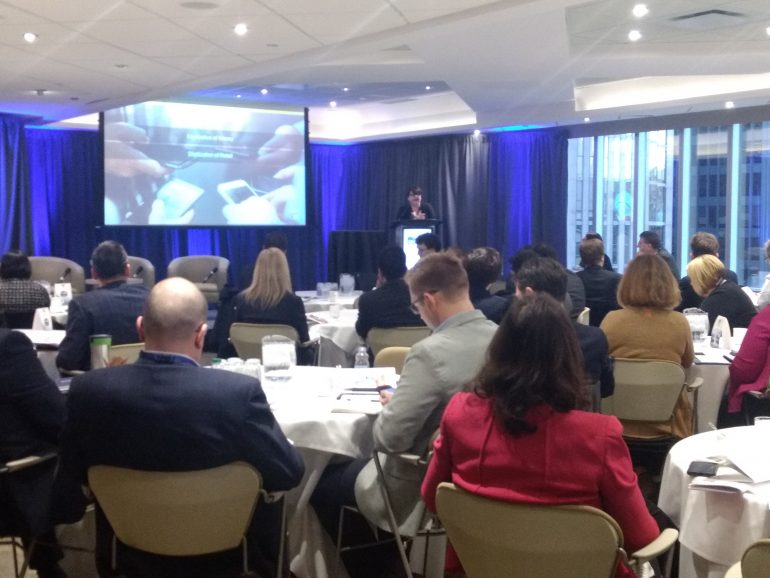At RFi Group’s third annual Canadian Payments Innovation Forum in Toronto, over 100 payments and banking executives gathered to examine how FinTech is transforming the Canadian financial services industry, and what providers can do to prepare.
“In the last 20 months, we’ve done 20 strategic partnerships globally,” said PayPal Canada president Paul Parisi. “It’s this concept of, do you build it, and a lot of larger payment companies have been stuck in this… like do we build it because it’s proprietary and makes us feel better about us and what we can do and how we can bring those innovative ideas to the market? Or do you partner with someone who’s already done it?”
“What we’re seeing is we’re moving from single apps to a connected experience.”
– Stacey Madge
While Parisi was talking about his company’s own experience, Parisi was speaking to a larger trend in FinTech over the past couple of years; rather than try to keep up with tech disruption brought on by nimble startups, it sometimes makes more sense to just partner with them. At the same time, it’s helped kickstart a trend of democratizing financial services for consumers.
“A lot of payment strategies are coming out of these partnerships. Opening up our network, and letting people choose payment methods and how and when they want to buy things, and what facility they want to use to fund was a risky move. But…the results have proven that this is the best strategy we’ve ever deployed,” said Parisi.
Debbie Gamble, VP of digital products and platforms at Interac, said that Canada has a strong history of collaborating. It’s a quality that’s important as Canadians come to expect more from their financial services; according to one study from Visa, Toronto and Ottawa were two cities leading the trend towards cashless services out of 100 worldwide cities surveyed. When it comes to the net benefits of cashless adoption on each city’s GDP, total direct impact on consumers, businesses, and governments was $7 billion USD for Toronto, and $1.4 billion USD for Ottawa.
After launching with Samsung Pay earlier this year, Gamble indicated that ‘cash alternatives’ would continue to be a focus and something to watch in the market. Due to Interac’s smaller size (the company has about 250 employees), Gamble said they just don’t have the “bandwidth” to do everything themselves, so turning to partnerships is key.
“The areas we really look at are how do we continue to deliver secure, innovative experiences to the marketplace with this emerging tech, and what can we do to leverage the infrastructure and pipelines we’ve brought to the Canadian marketplace,” said Gamble. “We strive to deliver alternatives to cash, and as a community, we’ve done an amazing job of delivering contactless capabilities at POS. Canadians moved more than $90 billion in etransfers this year, so our little country is significantly leading the space in P2P transfers.”
“I think we’re in a reasonably good position, but I think we’ve only scratched surface of these big themes for Canada.”
– Brian Lang
Stacey Madge, country manager at Visa Canada, said that Canadians are “so trained” to tap that digital wallet transactions are low, but new tech like Samsung Pay and Apple Pay can change that. “Today we use multiple apps and any technophile probably has about 100 individual apps on their phone, you use it to order your food, message a friend, or pay a bill but what we’re seeing is we’re moving from single apps to a connected experience,” Madge said, calling Wechat the greatest ‘super app.’ “We’re trying to learn from China.”
Going beyond consumer experiences, Mastercard president Brian Lang indicated that financial services providers must prepare for the needs of ‘smart cities,’ which will require more robust security measures. There are startups working to make this happen, including Toronto-based SecureKey, which is working to build a digital identity ecosystem with Canada’s big banks and IBM, and BioConnect, which is building authentication systems based on a person’s biometrics.
“My hope is that by building those we drive a lot more efficiency in the country, but more importantly we make thoughtful data-driven decisions as a country,” said Lang. “Those cities are then powered by a lot of IoT and by digital commerce, and that needs to be protected by leading-edge cybersecurity. I think we’re in a reasonably good position, but I think we’ve only scratched surface of these big themes for Canada.”


